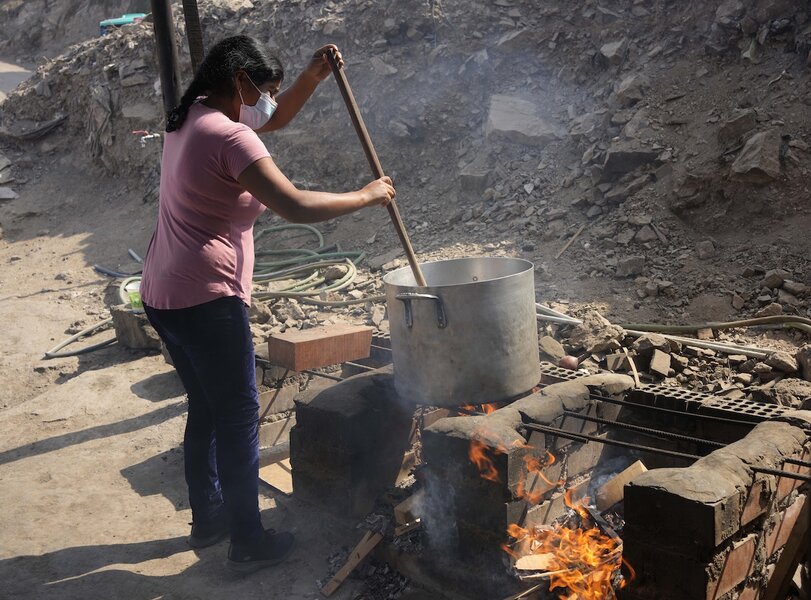As food prices skyrocket, Peruvians turn to 'common pots'
Loading...
| Ciudad de Gosen, Peru
Every day for more than two years, Cindy Cueto has woken up in the house she shares with her three children atop a desert hill in Peru’s capital, and wondered: “What are we going to eat?”
She bands together with her neighbors in impoverished Ciudad de Gosen each day to cook up a “common pot” of food, a survival strategy that surfaced in Lima’s sprawling shantytowns with the coronavirus pandemic. It has since expanded to ameliorate the impacts of the rising prices of food, fuel, and fertilizer due to global inflation, the war in Ukraine and a government ineffective in keeping its promise to help the most vulnerable.
The common pot, comparable to a small-scale soup kitchen, provides them one meal a day. Ms. Cueto and her neighbors try to track down the cheapest food in the markets, buying cow bones, chicken offal, rice, and potatoes. They keep their eyes open for any charity from more fortunate Peruvians.
“We don’t buy meat. It’s very expensive, we only have enough for bones to make soup,” Ms. Cueto, whose husband works as a security guard, said as she counted her coins. “The money goes like this,” she said, snapping her fingers.
On a recent Monday – like 15 other days since January – the common pot was empty because they failed to raise any money. A day later, after collecting the equivalent of $16, they bought two kilos (4 1/2 pounds) of chicken bones, five kilos of potatoes (11 pounds), and the same amount of rice to feed 70 people, especially children and the elderly.
The inflation sweeping the world has hit Peru’s 33 million inhabitants hard, especially the 10 million poor people who live on $3 a day. Monthly inflation in March reached 1.48%, the highest in a quarter of a century. Soaring prices for food and fuel, combined with the inefficiency of President Pedro Castillo’s government, have unleashed violent protests that have caused five deaths and led to calls for Mr. Castillo and Peru’s legislators to resign.
According to government data from February, there are at least 3,400 common pots in Peru, 70% of them in Lima. Most are in shantytowns like Ciudad de Gosen, where there is no running water, electricity is scarce, and residents have built their own houses and roads in the dusty earth of the desert hills surrounding Lima. Neglected by the government, they now have had to organize their own food supply.
Ciudad de Gosen residents say the price of cooking gas has tripled since the start of the pandemic. Ms. Cueto and her neighbors feed the fire under their common pot with wood scraps they are given twice a month as charity from a carpenter’s shop.
Trinidad Espinoza, a local cooking gas vendor, said even she uses firewood.
“I can’t even afford a canister myself,” she said.
The response by Peru’s government to rising hunger and spreading unrest has been ineffective, this despite coming to office on promises to prioritize the poor.
Mr. Castillo, a rural teacher before winning election, has changed his Cabinet four times during just nine months in office and been criticized for appointing inexperienced allies and neophytes to key ministries. Peru’s unicameral congress has twice tried to remove him from office.
Surveys by Peru’s major polling companies show about three quarters of Peruvians disapproving of his performance as president, and 79% disapproving of congress.
“They don’t care about people, they fight all the time for their interests,” said Enedina Avilés, who lives alone a few steps from the common pot.
To control the social unrest, protests, and road blockades that have hit the Andean country in recent weeks, the government has prohibited protests on major highways for 30 days. It has also lifted a fuel tax, but people complain that prices remain high.
On April 5, authorities briefly ordered Lima’s 10 million residents to stay in their homes and shut down public transport in a lockdown reminiscent of the coronavirus pandemic. A Lima lawmaker angered many when he justified the 22-hour lockdown by calling those living in the impoverished hills surrounding Lima “looters.”
Ms. Cueto’s husband, Walter Ríos, works far away from Ciudad de Gosen in a wealthy Lima neighborhood. Without public transportation on April 5, he had to make the 36-kilometer (22-mile) round trip to and from work on foot.
When her husband arrived home that night, she had prepared a bucket of salty water to soak his feet.
“They decide anything without thinking of the consequences,” she said.
This story was reported by The Associated Press.





